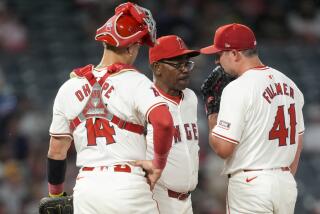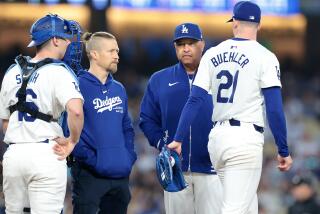Dodgers All-Star Corey Seager stays motivated to stick at shortstop

- Share via
On June 4, 2012, Corey Seager gathered with his family in Kannapolis, N.C., to watch the first round of the MLB Draft. Elation and relief coursed through him when he learned the Dodgers would select him with the 18th pick. He turned his attention to the broadcast, when he would be introduced to the baseball world.
In announcing Seager, commissioner Bud Selig mispronounced his name, ever so slightly. But the real shock came a moment later, when MLB Network host Greg Amsinger predicted his future.
“Corey Seager has what many scouts consider to be the prettiest swing in this year’s draft class,” Amsinger said. “That helped produce a big year for the All-American shortstop, who many believe will be a third baseman.”
At home, Seager sat stunned. He knew he was taller than most players at his position. He understood he would never draw comparisons to Ozzie Smith. But no one had told him he was too big to play shortstop.
“I was like ‘Huh? This was a really good time. And it went really downhill,’” Seager said.
The studio analysts discussed the aesthetic beauty of Seager’s swing and how he compared to his brother Kyle, who had become a regular with the Seattle Mariners. Then Amsinger twisted the knife one last time. “He’s going to move over to third base,” he said as a transition to an interview with Peter Gammons.
Seager never forgot the slight, even after he became an All-Star at shortstop. Amsinger was merely relaying an industry-wide worry about Seager, one that carried over into his first full season with the Dodgers.
One day last week, Seager unfolded his 6-foot-4 frame from a chair beside his locker and explained why he believes he can remain at shortstop. His proficiency stems from a series of preseason mechanical adjustments, an embrace of the organization’s usage of defensive shifts and his refusal to accept conventional wisdom about where he belongs on the diamond.
Nearly four months into 2016, Seager merits consideration in the National League MVP discussion. He ranks second among position players in FanGraphs’ version of wins above replacement and seventh in Baseball-Reference’s version of the statistic. He has hit 17 home runs and 27 doubles with an .888 on-base plus slugging percentage — all while playing more games at shortstop than any other big-leaguer.
His ability to handle the position enhances his value. Some defensive metrics treat him kindly. Seager ranked sixth among qualified shortstops in FanGraphs’ version of defensive runs above average heading into Monday’s games. He was tied for 11th in that statistic among all position players. He ranked sixth among shortstops in Ultimate Zone Rating, a metric that seeks to determine how much better or worse a fielder is performing than what is considered average at his position.
“I think it’s a little bit of a lazy analysis to say he’s going to move,” said Andrew Friedman, the Dodgers’ president of baseball operations. “Because you look at the high-waisted body and the height, and you think he’s going to have to move. But you spend time around him, you think about how hard he works at it, and you watch his ability to complete plays from all different angles. That should change your opinion.”
Even the metrics that take a less charitable view of Seager’s performance, like defensive runs saved or revised zone rating, place him in the middle of the big-league pack. Rival scouts consider him an average defender, capable of overcoming his limitations with his powerful arm and his adherence to the Dodgers’ defensive positioning.
“You don’t need to be able to go 30 feet to each side,” Seager said. “Really, you have to cover 10 feet, maybe. It’s probably five feet on each side that you’re like ‘This is what I have to cover. If it’s hit here, I need to catch it.’”
His size does create challenges. During the winter, after the Dodgers hired him to coach the infield, Chris Woodward studied film of Seager. He kept an eye on Seager during drills at the club’s Camelback Ranch spring training complex. A pair of height-related deficiencies caught his eye, starting with the length of his stride.
When Seager stretched his legs in the field, he could be caught off balance by the skips and hops of the ball. In order to “maintain his body control,” Woodward explained, Seager needed to utilize shorter, choppier steps. Woodward instructed him to save his full gait for pop-ups in the outfield, when he had to cover more ground.
Woodward also noticed how Seager popped up after fielding grounders. By straightening his frame, he created a downward angle on his throws, which often forced his first baseman to scoop balls out of the dirt. Woodward showed Seager how to utilize his legs in the throwing motion.
For Seager, the tweaks felt awkward. To trick his mind, Seager relied on his finest attribute: He thought about hitting. At the plate, he strives to keep his lower half flowing in concert with his upper body. The same principles applied to fielding.
Seager also found a benefit to missing a significant amount of the spring with a knee injury. Upon his return, he operated with a clean slate of muscle memory.
“I hadn’t had any ground balls, so it was like ‘OK, this is a good time for a fresh start,’” Seager said. “I’m not fighting old habits now. I’m creating new ones.”
First baseman Adrian Gonzalez said, “His throws this year have been great.”
As the years pass, Seager will only get larger, his frame more unwieldy. The chorus suggesting he should leave shortstop may grow louder. He does not intend to listen.
“There were a lot of people who had never seen me play who were like ‘Oh, he’s got to move,’” Seager said. “It was amazing how the higher up I got, the more people who were like ‘Oh, maybe he can stick.’
“I’m like, ‘Yeah, guys, you finally watched me play. Writing me off before I even started.’ I’m glad the Dodgers believed in me.”
andy.mccullough@latimes.com
Twitter: @McCulloughTimes
More to Read
Are you a true-blue fan?
Get our Dodgers Dugout newsletter for insights, news and much more.
You may occasionally receive promotional content from the Los Angeles Times.







